With cameras and photos everywhere, it's hardly surprising that children–who are naturally inquisitive–might want to have a go at taking photos themselves. It's not that hard to give them a helping hand!
Canon's rumoured withdrawal from the compact market is no great loss
It is only a rumour, but there are suggestions that Canon will soon cease production of lower-end, sub-$200 point-and-shoot cameras. Given the steady erosion of compact camera sales and their inability to compete against the convenience and ubiquity of the smartphone, it's hardly surprising. It's also a step taken already by Olympus by Fujifilm. And just as we stated in the cases of both Olympus and Fujifilm, this is a good thing. By my count since January 2012, Canon has released twelve IXUS model cameras and ten Powershot A-series cameras. These are typically regarded as its cheaper and cheerier models. They tend to range between £80 and £180, although the odd few come in much higher than that, have more than enough megapixels to keep the pushiest salesperson smiling, a decent optical zoom range, the ability to record video, and sometimes are blessed with image stabilisation. Unlike Canon's dSLR range, which comprises a controlled range of cameras with clear spec expectations at given price-points, it's verging on the impossible to discern one compact model from another. Their variations in spec are so slender that they all merge into one rainbow-coloured haze.
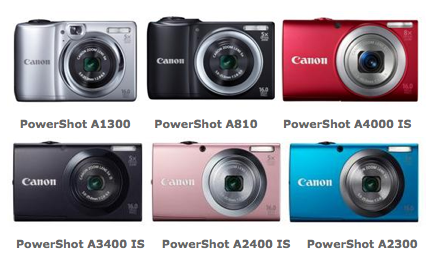
Herein is their downfall. First, they're not something that you'd go out to buy when you have a wirelessly connected smartphone in your pocket. There's not really enough value-added to justify the outlay. Second: when there are so many different cameras with so little to differentiate one from another, it's little wonder that consumers' eyes glaze over and they decide to stick with what they now know: their iPhones and their Samsung Galaxys. Choice is a good thing, but sometimes offering too much choice, without making obvious why it's needed, is self-defeating.
Let's not forget, that little tot-up of cameras didn't include any of Canon's Powershot SX range, which covers the superzooms, its D-series rugged cameras, the S- and G-series, which are its high-end compacts, and the quite-frankly-ridiculous N-series.
If anything can convince you that Canon really ought give up on the definitely-fled smartphone crowd, it's the N-series of cameras. They smacked of desperation, of designers under pressure to produce something 'young and funky and with-it' in an attempt to recapture a market long since gone, and engineers who'd rather be working on any other project than that one. Yes, they are out of the 'sub-$200' bracket of cameras that are expected to be axed, but they have no place in the range, either.
By relieving itself of the burden of the cheap end of the compact camera spectrum, Canon can refocus its attentions on the areas where there is hope, where there is potential, where there really is a market. Most definitely on its dSLRs, that seem to have gone off of the boil ever so slightly of late. Perhaps on its higher-end compact cameras, which are still selling and I believe show that compacts do still have a place in the canon of cameras, but could benefit from some innovation and development. And maybe even in the mirror-less division, where the EOS M has been so painfully disappointing.
This shouldn't be regarded as a move of panic or despair on Canon's part. I actually think it's rather mature. It shows how it might be beginning to analyse the market, to identify its strengths and weaknesses, and to come to terms with the idea of an evolving photography world.
Olympus' Stylus 1 feels like a curate's egg of a camera
The best way that I can describe Olympus' new Stylus 1 premium compact camera is as a curate's egg: it's good in parts. Some elements of it really appeal and some leave me indifferent at best. For a camera that Olympus had hoped would shake up the top end of the compact camera market it feels rather lack-lustre.
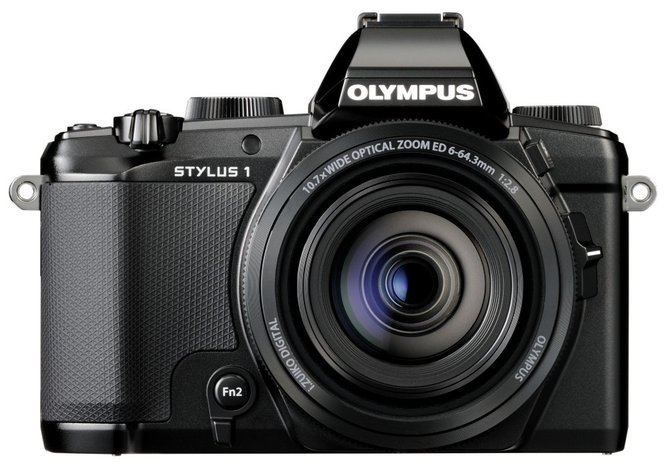
For a start, the zoom range is impressive. At the equivalent of 28 to 300mm, it beats its Nikon, Canon, and Fujifilm rivals into a cocked hat. None of those (the Nikon P330, Canon S120, Fujifilm XQ1) goes beyond 120mm. And the Stylus 1 has a constant ƒ/2.8 aperture across the range; there's no dropping down to ƒ/5.6 as you zoom in on your subject. But this is where some trade-off comes in. The others have bright ƒ/1.8 apertures at their lenses' widest angles, which narrow as the focal length increases. What would you prefer?
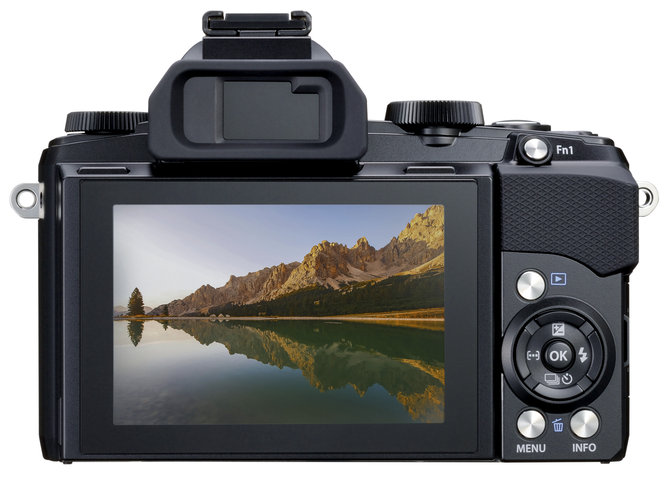
The standard resolution for this type of camera is 12 megapixels and Olympus hasn't deviated from that. Is there any need to? There's wi-fi, which you'd expect; a customisable lens ring and to button to put your most-used functions where you want them; it has a sensitivity range of ISO 100 to 12,800; and everything is powered by a TruePic VI processor.
Aesthetically, the Stylus 1 is channeling the OM-D E-M series, a look that is driven home by the inclusion of an EVF that comes with a 'hump'. This is a strange addition for something that is designed to slip into a pocket; it measures 116 by 87 by 56.5mm, but would you want something lumpy sitting against your thigh? There appears to have a disconnect between the camera's technical intentions and its ergonomics. It's not a design that's blowing back my hair and I'd be inclined to pass it over in favour of the Fujifilm XQ1.
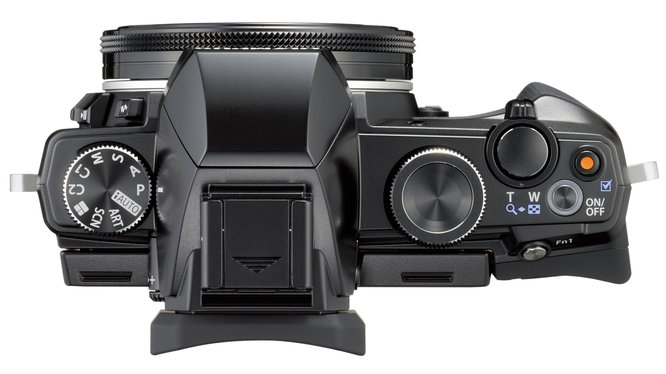
The biggest disappointment, though, is the 1/1.7" sensor. Fujifilm squashed a 2/3" sensor into the XQ1 and Sony has managed a full-frame sensor in a compact body. We know that it can be done and this is where Olympus really could have broken away from Canon and Nikon, but it hasn't. And at £550 (or $700), it feels very unsatisfactory.
There are things to like about the Stylus 1, but for me, there isn't enough. Olympus, you could have done better.
Q&A: What's the best compact camera with an optical or electronic viewfinder?
Personally, I have a bit of a love relationship with the Canon S-series of cameras. Yes, they don't have an optical or EVF viewfinder, but think about it this way: In designing these cameras, Canon decided to create the highest-end compact cameras they could, and there was no way that they were going to stick a poor screen on there.
Even in bright screen, my S95 (and, subsequently the S100 and S110) work fantastically well, regardless of situation: I've used mine extensively both under and above water (see www.flickr.com/search/?w=
The other benefit of no viewfinders is that the screens can be far, far bigger, which has its own benefits.
TL;DR: Don't ignore cameras without viewfinders, LCD tech has gotten very far in the past few years.
What's in a name? Pentax Ricoh to become Ricoh
From 1 August 2013, the Pentax Ricoh Imaging Company Ltd will be no more. Instead, it will be the Ricoh Imaging Company Ltd. It took a little while in coming, but a new name wasn't wholly unexpected after Hoya sold Pentax to Ricoh in 2011. The Pentax name won't be going away entirely, however; it'll remain as the brand name for dSLR and interchangeable lens cameras as well as binoculars. The Ricoh brand will apply to compact cameras and new technological innovations.
After Olympus and Fujifilm axed the lower half of the compact camera ranges earlier this year, Pentax/ Pentax Ricoh/ Ricoh is taking a slightly different tack. Rather than axing the line (something that might happen in the future), the cameras are being severed from the Pentax name. That's one way to maintain brand integrity!
Gift-giving to photographers

Photojojo's nifty ring flash adapter
Earlier this week I put together a list of sub-£25 ($40) gift ideas for photographers. If you've a little bit more to spend, these suggestions should keep you going. They start at $40, take you up to $550, and there should be something for everyone!
Ring Flash Adapter
Ring flashes don't necessarily come cheap, but a ring flash adapter–which makes use of your existing external flash–is a handy alternative. Of course it was the clever people at Photojojo that thought of this one!
A compact camera for kiddies
If you've a budding photographer in the house there's no better way to encourage her or him on the path to becoming their generation's Ansel Adams than with a 'proper' camera. It doesn't need to be fancy, but it does need to be suitable for little fingers. I've been consistently impressed with Fujifilm's entry-level compacts, and this year is no different.
Take a look at the Fujifilm AX500. With 14 megapixels of resolution, movie-making capability, digital image stabilisation, and running off of two AA batteries, it's ideal.
£50 from John Lewis or $73 from Amazon US
Lensbaby Spark
Buying lenses for other people is very rarely a good idea, unless you know precisely what they want or need. A Lensbaby Spark, however, is a fun fixed aperture selective-focus option that should get the creative juices flowing.
Dropbox subscription
Earlier this year I wrote about the perils of not having a proper back-up protocol in place. If your photographer friend is living dangerously with their digital storage solutions, why not treat her or him to a Dropbox subscription.
$99 for 100GB annual subscription
Adobe Lightroom 4
Adobe's Lightroom 4 is a superb piece of kit. No, it doesn't have the bells and whistles of Photoshop, but then that's Photoshop. Instead it offers brilliant straight-up editing and photo management. If you know someone who has been uhming and ahhing over it, help them out!
£106 from Adobe UK or $149 from Adobe US
A 'serious' compact camera
My dSLR is my camera of choice and I love my iPhone, but it's very rare that I go anywhere without a pocket-sized compact with full manual control in my handbag. I love my Canon S95 and the reviews of the S110 have been very good. Many people have waxed lyrical over Sony's RX100, too. But the one that's really catching my eye right now is the Olympus XZ-2.
£425 from Amazon UK or $550 from Amazon US
And of course, don't forget to check out last year's slightly-more-expensive gift suggestions.
Photokina 2012: a round-up

Photokina is by turns exciting and exhausting. So much is going on you barely know where to look first or next. I've done my very best to keep you abreast of the major announcements here on Pixiq, but just in case you missed something, and to cover those announcements that I couldn't squash onto the front page, here's the Photokina 2012 round-up.
Canon
Canon's big news for Photokina was the full-framed sensor but diminutive-of-body 6D. Sticking with the 'small-is-beautiful' theme, they also updated their high-end compact camera range, with the G15 and the S110.
The G15 is coming in approximately 17% smaller than the G12 (yes, Canon skipped G13 and G14) but with the brightest lens in the series yet. It ranges from ƒ/1.8 at its widest (28mm in 35mm equivalent) to ƒ/2.8 at 140mm (also 35mm equivalent). It has a 12 megapixel sensor with a DIGIC 5 processor, sensitivity that reaches ISO 12,800, a burst rate of 10 frames per second, and everything that you'd expect from the G-series: Raw capability, full manual control, HDR mode, and image stabilisation. This one will be about £550.
I'm still languishing with a two-iterations-ago S95, which my little brother has currently seconded. If he decides to keep it, I'll be quite happy with the upgrade to the S110. This one has an ƒ/2.0 lens with 5× optical zoom, a 12 megapixel sensor and DIGIC 5 processor, just like its predecessor, the S100. However, its sensitivity now reaches ISO 12,800 and it comes with wi-fi and a touch-screen. All for about £430.
If you're looking for something with more zoom, there's also the SX50 HS, which has a 50× optical zoom (and plenty of accompanying image stabilisation), 12 megapixel CMOS sensor and DIGIC 5 processor, Raw capability, and manual control. It'll cost about £450.
Fujifilm
Fujifilm didn't get carried away at Photokina. But then they didn't really need to as the XF1 was named as star of the show. I admit it, I'm a tiny bit in love with it.
Hasselblad
Hasselblad seemed to turn more heads with its intention to start producing the EVIL Lunar camera than it did with its pre-Photokina H5D announcement. But then when one of the most famous names in medium format photography unveils a 24 megapixel, mirror-less, interchangeable lens camera that is going to sell for around €5,000, it might be a bit of an attention grabber. Not forgetting that the designs include the use of carbon fibre, wood, titanium, leather, and precious metals.
As for the H5D, it will come with 40, 50, and 60 megapixel options, as well as 50 and 200 multi-shot versions. It features improved weather-sealing, new, larger buttons and a brighter display, Raw + JPEG mode, and is bundled with Adobe Lightroom 4.
Leica
As well as five new cameras and the marketing decision to drop iteration numbers from the S and M series cameras, Leica also popped up with three lenses, some adaptors, and a clutch of binolculars. Lens-wise, you're looking at a 24mm ƒ/3.5 prime for its S series (that's a 19mm equivalent in 35mm format); a 30-90mm ƒ/3.5-5.6; and the first fully adjustable tilt-shift for its S series, a 120mm ƒ/5.6.
Lensbaby
Lensbaby went for a fun, cheap, and allegedly youthful addition to its range, the Spark. I reckon anyone can use it, though.
Nikon
Nikon's big announcement came in advance of Photokina, when it also dipped its toes into the smaller-sized but bigger-sensored waters with the D600. There was also a new lens for 1 Series of cameras: an 18.5mm ƒ/1.8, which should retail around £180.
Olympus
As for Olympus, they announced four new lenses, three new cameras, two turtle doves, and one re-branding.
Panasonic
Panasonic has added the GH3 to its Lumix range. You're looking at a 16 megapixel, wi-fi-enabled, weather-proofed camera here, but one that is definitely aimed at video, with its 1080 50p AVCHD output and promotional video by Philip Bloom. Not forgetting the headphone jack for external sound recording. It'll probably cost around £1,000 and be available from November 2012.
Pentax
Pentax unveiled their newest cameras in advance of Photokina. There's an upgrade to the K-5, in the form of the K-5 II; a specialist K-5 II S, which is the K-5 II with the anti-aliasing filter removed; and the Q10, which revamps the tiny Q EVIL camera.
Samsung
Two new lenses for Samsung: a 12-24mm ƒ/4.0-5.6 and a 45mm ƒ/1.8, both for their NX cameras.
Samyang
Samyang brought its 10mm ƒ/2.8 lens to the Photokina party. With an equivalent focal length of 15 or 16mm in 35mm format, it has been aimed at architectural and landscape photographers. It'll probably be ready in early 2013.
Sigma
Sigma announced that it is dividing its lenses into three categories for marketing purposes from now on: Contemporary, Art, and Sport.Contemporary is about the latest in technology and optical development; Art focuses on expression and optical power; Sport is probably self-explanatory, telephoto and super-telephoto lenses aimed at capturing things in motion!
Accordingly, it has released one lens in each of these categories. There's a 17-70mm ƒ/2.8-4.0 macro; a 35mm ƒ/1.4 prime; and a very tasty sounding 120-300mm ƒ/2.8, which is dust and moisture resistant.
Sony
Sony did the pre-Photokina announcement thing, unveiling its A99 full-frame, translucent mirror flagship, its pocket-sized full-framed RX1 compact, and the NEX-6 last week.
If you're thinking of splashing out on a new EVIL camera, the NEX-6 comes with a 16 megapixel CMOS sensor with a maximum sensitivity of ISO 25,600. There's a hybrid auto-focus system and 10 frames-per-second burst mode. And built-in wi-fi, which is the new must-have.
Tamron
Tamron added two lenses to line-up, both of which have piqued my interest. First there's a 90mm ƒ/2.8 macro, followed by a 70-200mm ƒ/2.8 telephoto. Both feature vibration compensation and ultra-silent drives, and will available for Canon, Nikon, and Sony mounts. No dates or prices yet, but I'll be keeping an eye open for them.
That's a wrap?
Well, it's certainly the headline offerings. It doesn't look at gadgets and gizmos, camera bags, printers, editing software, or just about anything else that Photokina has to offer.
But what is there to take away from Photokina 2012?
Definitely that wi-fi is the new must-have for any camera, and that sensor technology is bringing us to a point where full-frame is becoming a financial possibility for cheaper and lighter cameras. I don't think it will be too long before anyone who isn't completely dedicated to having the smallest camera possible will be shooting with a full-frame digital sensor as standard.
A tiltpod? What's a tiltpod?
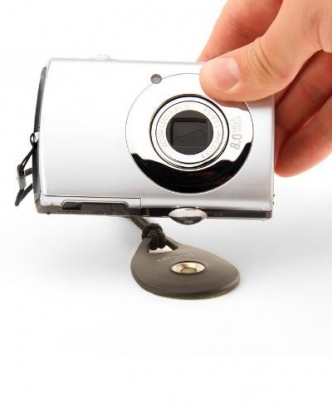
When I was first asked if I'd test-drive a tiltpod, I shrugged my shoulders and thought 'Why not?' A portable, tiltable compact camera or iPhone securing device? There are worse things I could be asked to do, even if I weren't quite sure how I'd end up using them.
About a month on, I love my iPhone tiltpod and I can see the benefit of the compact camera version.
Tiltpods come with a lightweight, magnetic base that's set with a small socket, and a corresponding magnetic ball joint that either screws into the tripod mount of your compact camera or has a slot for your iPhone 4 or 4S. The ball sits in the socket, is held there by the marvel that is magnetism, and being a ball-and-socket, rotates. Rather than being tripods, they're more like gastropods, I suppose.
The camera version's base attaches to your camera via a lanyard and the ball joint is unobtrusive enough to live permanently in the tripod mount. (If you've an off-centred tripod mount, there is a sticky ball joint, instead.) It's a clever bit of design: the chances of losing one bit or the other have been diminished whilst the possibility of actually using it is increased by virtue of it always being there. As for the iPhone version, it can dangle most comfortably from your keyring.
Now that the ergonomics have been covered, what about using the things? Quite serendipitously, a project that is currently consuming just about all of my waking moments has demanded a heap of iPhoneography recently. The tiltpod has proved its mettle here, especially when it came to self-portraits. Find a flat surface, set the angle, use your self-timer function of choice, and away you go. Even if you don't need to be quite so artistically-inclined as my endeavours, a tiltpod is still ideal for grabbing photos of you and your beloveds, instead of pictures with oddly angled arms or devoid of one of your party.
Or you could just use it for Facetiming, if that's more your thing.
As for the camera version, it's pretty much the same deal. Find your surface, set it up, off you go. I've not had any issues with wobble, slide, or slip, and positioning it has been a question of how daring I've felt.
Tiltpods aren't without their limitations, though. Unless you magnetically attach the base to a radiator, lamppost, or railing, you're restricted to taking landscape oriented photos with the camera version. Whether or not you've the stomach to dangle your P310 from a balustrade via a magnet is up to you. I mean, I tried it, in the interests in writing a review, but I don't know if I'd be prepared to step beyond catching distance of my camera lest gravity get the better of it. (The tiltpod team does point out you can always attach the sticky ball joint to your camera to facilitate vertically-oriented shooting, but if you're already using the sticky foot, you can't. And you might not want to stick a sticky foot to your camera, either.)
If you precision-angle your iPhone, you can stand it vertically in its tiltpod. This set up does, however, feel a little precarious for my comfort. I would have apreciated just a little more depth and width in the base, so that I could use it to take portraits and not have to worry about my iPhone tumbling into oblivion, or have my iPhone standing up on my desk without fear of it toppling over should a door slam. Still, it hasn't stopped me from using the tiltpod to cradle my phone on my desk horizontally.
Finally, they do need to sit on a surface: a wall, a shelf, a nest of tables that I stacked one of top of another to gain sufficient height for one particular photo. But the problem itself isn't insurmountable (although my furniture obstacle course might have been) and it's the trade-off for their significant advantage over other camera-stabilising devices: they are emininetly portable.
The camera version stays attached to your camera, so it goes with you (and your camera) automatically. The iPhone version attaches to your keyring. They're designed to be used, not left languishing in a drawer or at the bottom of a bag.
At a smidge under $15 each, a tiltpod doesn't break the bank, although I'll admit that I probably wouldn't have gone out and bought one for myself. I am, though, very happy to have them in my possession. If you do lots of iPhoneography (or Facetime frequently), the iPhone version is worth it. And I reckon that they make pretty nifty presents, too.
Tiltpods are available from Gomite's webstore, costing $14.95 each.
Disclaimer: Gomite did send me two unsolicited review models. I didn't pay for them and I have been allowed to keep them.
An itty-bitty problem with the itty-bitty Canon S100

Canon's S100: gorgeous and very capable, but some models currently have a sticking point
It's not exactly ideal when the retractable lens of your compact camera stops retracting and is left fully extended if it gets a bit too hot or sticky outside. Unfortunately this is the precise scenario that's been afflicting a handful of Canon S100s. Apparently an internal connection fails in some of the cameras if the temperature or humidity levels get too high.
I can't see that happening in these parts right now, it's just too cold. But it'd be a different matter entirely in Florida.
It's only cameras with serial numbers that begin with the digits 29 through to 41 that are affected. (So the serial number would read 29xxxxxxxxxx, or 35xxxxxxxxxx, or 41xxxxxxxxxx, for example.) Canon is offering a free repair if yours happens to be one of the unfortunate ones. It doesn't matter if it's out of warranty, and there are rumours of refunds if you had it repaired independently, too.
Get in touch with Canon Customer Support wherever you are, and they'll help you out if you have an affected camera.
Choosing your first dSLR camera

Whenever a new excuse for buying stuff (Christmas? Birthdays?) rolls around, the retailers are rubbing their money-grabbing little paws in glee, in anticipation of making a killing over the holiday seasons. Be that as it may, fact remains that there is a lot of choice out there, and whether you are buying your first camera, or whether you are out shopping for a friend of family member, you might need a hand.
Welcome to the 7th edition (!) of my in-depth guide to choosing an entry-level dSLR camera: What should you be looking for, what should you be buying, and why? It’s all in our handy shopping guide, right here…
Where should you even begin?
Once you’ve decided to start looking for a dSLR, you might have some reason in mind already. Perhaps you feel as if you’re outgrowing your compact camera, whether that’s creatively or technically. Maybe you’re not really feeling as if you’re challenging yourself enough as a photographer. Either way, you’ve decided to go play with the big boys – welcome aboard!
The first and most important thing you need to know is that there aren’t any really bad digital SLR cameras out there.
In fact I would argue that there aren’t actually any bad digital cameras on the market anymore in general – stick to a respected camera brand, and you’re home free. If we’re looking at compact cameras, you can buy a respectible camera for under $100 – the Canon Powershot A2200, for example wil set you back $99 or thereabouts, and is a lot of camera for your hard-earned dollars.
Anyway, we were talking about dSLR cameras. Here are a few things you should be looking at..
Things to consider before making your choice
Do you already own a SLR camera?
If you have already bought into a particular brand of camera, take a good, hard look at your lenses. If you’ve bought a lot of high-end lenses and flashguns etc, swapping from one brand to another might have a lot of hidden costs in them. On the other hand, if you have a lot of old, tattered equipment with scratched lenses, see it as an opportunity: eBay off the lot, and start afresh.
Canon or Nikon?
This is a perennial question which I’m not going to go anywhere near.I defy anybody to be able to tell the difference between a camera taken with a Canon or with a Nikon camera. Or a Sony. Or a Panasonic. Or a Sigma. Things have moved on hugely since the raging Canon-Nikon debates of the early 1980s (and they scarcely made all that much sense then).
Whichever camera system you buy into, you’re going to live with for a while (probably), so do think about it. You – not your camera equipment – is going to be the bottleneck, so don’t worry too much about what you might have heard form the old graybeards…
Buying into a system?
You know best what kind of a photographer you are. If you’re likely to start buying high-end lenses (or ‘fast glass’, as it’s frequently called among seasoned photographers), then you have two choices: Canon or Nikon. There are a lot of other people out there building great DSLR cameras, but once you start talking seriously high-end equipment, it’s one of the two big ones, I’m afraid.
On the other hand, if you are a semi-serious hobbyist, don’t discard other camera brands out of hand: Sony, Olympus and Panasonic are building some very capable cameras indeed – with some serious money-saving opportunities, too!
Body or glass?
If you have to choose between buying an expensive body and cheap glass or a cheap body and expensive glass, then go for the posh lenses. Every time. Personally, I am still using lenses that I bought nearly 10 years ago, even though I’ve changed my camera bodies half a dozen times since: You can take fantastic photos with an entry-level body and expensive lenses.
Putting bargain lenses on a top-level body is, frankly, a complete waste of money. Even better: Buy yourself a nice prime lens, and be amazed at what your camera body can do.
Megapixels?
In general, don’t worry about megapixels – most dSLR cameras come with 10 megapixels or more, and that’s enough. Hell, there’s even a prominent group arguing that more pixels aren’t necessarily better, and that 6mpx is all you need, really. I’m inclined to agree – you very rarely use them at full resolution anyway. What I’m trying to say is that Megapixels should be the last thing you look for in a digital camera in general – and a dSLR especially.

The above photo was taken with... an iPhone. Proving that any camera can take a good photo.
So, to summarise:
- Don’t worry too much about the brand of your camera body
- Buy Canon or Nikon if you anticipate dropping a lot of money on lenses in the long run
- Spend your money on lenses, not camera bodies
- Oh. and also consider looking into EVIL cameras - they're smaller and lighter than SLR cameras, but you keep the ability to swap lenses, and they can take great-quality photos! (loads more info about EVIL photography here)
3 great bargains
So, you’ve decided to leap into the pool of DSLRs, but you want to spend as little money as possible? These three cameras are your best options:
Sony Alpha A390
 The Sony Alpha 390 is an absolute bargain, and a great entry into the world of SLR. You get 14.2 mpx (more than enough), RAW image format (which is a must), and an incredibly nifty little feature: In-camera optical ‘SteadyShot’ image stabilisation! This means that any lens you connect to the Sony Alpha camera will be image stabilised – this is a feature you pay tons of money for in the lenses of other camera manufacturers!
The Sony Alpha 390 is an absolute bargain, and a great entry into the world of SLR. You get 14.2 mpx (more than enough), RAW image format (which is a must), and an incredibly nifty little feature: In-camera optical ‘SteadyShot’ image stabilisation! This means that any lens you connect to the Sony Alpha camera will be image stabilised – this is a feature you pay tons of money for in the lenses of other camera manufacturers!
The Sony Alpha lenses are compatible with Minolta AF and Konica lenses, so you get a reasonably good choice of glass, and the camera has a pretty wide shutter speed range of 30 seconds to 1/4000th of a second.
On top of all this, the Sony can be picked up with a fabulous kit lens – sure, it’s not the best glass you can buy, but who cares when you’re eager to get started. You can always chuck away (or eBay) the kit lens later, and upgrade to something better, once you know what kind of photos you’re likely to be taking!
You can get the Sony Alpha 390 with a kit lens from Amazon.com for about $449 and from Amazon.co.uk for about £349.
Canon EOS 1100D / Canon Rebel T3
 The world of digital cameras has come a very long way indeed. I remember buying my first DSLR in the mid-to-late 1990s, and, well, you’d pay a small fortune for something that wasn’t all that amazing.
The world of digital cameras has come a very long way indeed. I remember buying my first DSLR in the mid-to-late 1990s, and, well, you’d pay a small fortune for something that wasn’t all that amazing.
These days, though, you’re not needing to spend that much money to pick up a big-brand SLR camera. Obviously, Canon felt Sony and the other budget-DSLR manufacturers breathe down their neck, and they had to respond. And boy, did they respond: The EOS 1100D / Rebel T3 is one heck of a camera. Sure, so they’ve cut a few corners here and there, but, frankly, I don’t give a damn.
Personally, if I were to buy a SLR today, I’d buy one of two cameras: A Canon EOS 5D mk III (which costs a small fortune), or a 1100D / T3. Why? Because the imaging sensor is brilliant, and you can start saving up to buy lenses that will be with you and your camera system for a decade or more. When you finally out-grow the 1100D, eBay it and buy a mid-range camera (like the Canon 600D), or start looking at spending serious money for a serious camera (Canon 5D mk III if you want full-frame coverage, 7D if you don’t) – but none of the money you spent on lenses was a waste: It’ll all still be there, ready for you to snap away.
Of the bargain-snappers, only the 1100D / T3 has a CMOS sensor – which makes a surprising difference in image quality: Not necessarily better, but for some reason the grain on a CMOS sensor at higher ISO is a lot more similar to film than CCD sensors pushed to the limit… All of which means that the 1100D photos ‘feel’ more natural when you look at them.
You can get the Rebel T3 from Amazon.com for about $490 or the Canon 1100D from Amazon.co.uk for about £400 – both with a Canon EF-S 18-55 kit lens.
Nikon D3100
 Nikon’s baby camera is the D3100 – and it’s another bloody strong contender to the bargain crown. It comes with a super-advanced light meter – the 3D Matrix metering system borrowed from far more expensive Nikon cameras, which means that the Nikon is definitely the most capable in terms of getting the light measurements right.
Nikon’s baby camera is the D3100 – and it’s another bloody strong contender to the bargain crown. It comes with a super-advanced light meter – the 3D Matrix metering system borrowed from far more expensive Nikon cameras, which means that the Nikon is definitely the most capable in terms of getting the light measurements right.
The other thing the D3100 gets right is that it has a fabulous 3-inch LCD screen on the back of the camera, which makes a huge difference when you’re checking your photos in the field, to ensure you've captured what you're looking for all right.
Just like the Canon camera, the Nikon is an opportunity to start climbing the ladder – Buy the most expensive lenses you can afford, get some tasty flashguns, and they’ll be with you for a long time indeed.
I have to admit that I’m a Canon man at heart (I’ve used Canon cameras since I stole my dad’s Canon A1 out of the cupboard when I could barely walk. I didn’t break it, luckily), but it’s starting to seem as if Nikon currently have a nicer progression through the cameras – the D3100 is a peach, and the D5000 or D5100 – which is the next step up without being that much more expensive – is a deceptively simple, yet very serious, camera, for serious photographers.
You can pick up a D3100 from Amazon.com for about $640 and from Amazon.co.uk for £440 or so.
So… What should I choose?
If you want to take the step from compact cameras to SLRs, but foresee that you’ll continue being a casual amateur, go for the Sony. It’s a great little camera, a fantastic bargain, and the lenses available are not bad at all.
If you are ambitious in your photography, grab a dice. Throw it. Even numbers are Canon. Odd numbers are Nikon. They’re both absolutely brilliant cameras, and – considering what you get for your money – bargains. The Canon has a slightly better imaging sensor (but you wouldn’t be able to tell until you’re at higher ISO speeds) and the Nikon has a marginally better light meter (which doesn’t make that much difference in real life) and a better screen (which does). Seriously, if you’re having trouble making up your mind, throw the dice. It’ll save you a lot of headache.
Any final tips?
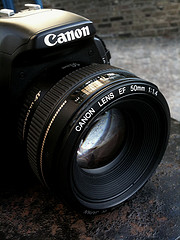
I know I’ve repeated this several times in this article, but if you’re new to SLRs, I would advise to buy the entry-level model from a manufacturer. Start taking photos – you won’t out-grow your camera body for a while, trust me on that, but you might out-grow your lenses. Start by buying a ‘Nifty Fifty‘ (a 50mm prime lens). Most manufacturers have a f/1.8 which is good and a f/1.4 which is great…
Once you have one of those, start thinking about the type of photography you do. If you want to start shooting macro, you’ll need to start looking into a macro lens. If you want to photograph gigs or wildlife, you’ll want a fast tele-zoom (I can’t recommend Sigma’s 70-200mm f/2.8 DSM lens highly enough – it’s a bargain for what you’re getting). If you’re more into in-door or landscape photography, you want to go wider – but only you know exactly what you want.
Buying cheap lenses is false economy – unless you don’t really know what you want to take photos of. If you’re just experimenting, flailing around a little (as we all are, at first), stick with your prime and your kit lens for a while. If you find yourself at the wide end of your kit lens most of the time, perhaps it’s a sign you need to spend a bit of cash on a wider lens. If you’re constantly at full zoom… well, you figure it out.
If you’re worried about spending hundreds – if not thousands – of dollars (or pounds, should you be on my side of the pond) on glass, go ahead and rent the lens you’re considering for a few weeks. Does it do everything you want it to? Is it too heavy? Does it feel right? Is it fast enough? If you’re not happy, rent a different lens, and keep searching. When you find the right lens(es) for you, you’ll know it – and that’s the right time to start shelling out the big bucks.
Seriously: Buy glass first. (If you want to learn more about lenses, I've got everything you could possibly want to know right here...) Worry about camera bodies later. By the time you have bought some serious lenses, you’ll know what you need from a camera (wide angle? Full-frame sensor. Sports? Fast, high-frames-per-second camera. Walking a lot? Buy a capable, but light-weight camera body… Etc)… But it’s a supremely silly thing to do to spend a lot of money on a camera body until you know what you really want/need.
So, Haje, what do you use?
 I’ve had a lot of cool cameras in my time – I worked as a freelance photographer for a while, and bought all the top-shelf gear. At one point, I drove around in a £1,300 car with £49,000 worth of camera equipment in the boot. I think it’s pretty safe to say that I’m a gadget nut, and a camera aficionado to boot.
I’ve had a lot of cool cameras in my time – I worked as a freelance photographer for a while, and bought all the top-shelf gear. At one point, I drove around in a £1,300 car with £49,000 worth of camera equipment in the boot. I think it’s pretty safe to say that I’m a gadget nut, and a camera aficionado to boot.
… Which is why it might surprise you that currently, my main camera is... a Canon EOS 550D. It’s not the newest camera on the market anymore. It never was the best. But it does everything I need from a camera: It’s plastic, so it’s reasonably light weight. It’s relatively sturdy. It uses SD cards (which plug straight into my MacBook Pro – it’s a small thing, but I like it).
The five-fifty takes all my lenses (I have loads, but the ones I’ve used in the past 6 months are a Sigma 17-35mm f/2.8-4.0, a Canon 50mm f/1.4, a Sigma 70-200 f/2.8, and my Lensbaby G3 lens), and it doesn’t look too conspicuous. It’s also cheap enough that I’m not too crazy worried about it getting stolen or dropping it. All in all: Perfect for my uses. And it's one cheapest camera you can buy with a Canon badge on it.
This article was first published in 2007, but has been updated with the most relevant information every year since. It was most recently updated in April 2012.
Red eyes and how to avoid them
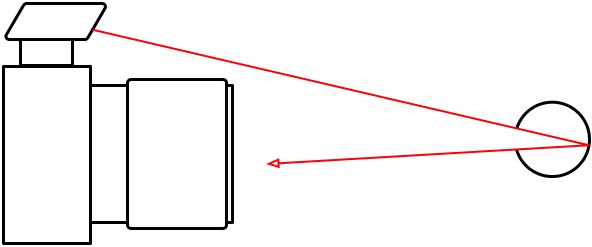
The Red Eye phenomenon is something that occurs when you take a picture of someone. If you have a compact camera and you’ve taken a few rolls of pictures, chances are that you have stumbled across the phenomenon, during which the eyes of your subject end up glowing an eerie red glow.
It's easy to avoid, and easy to fix if you failed to avoid it, but in this article, we'll take a quick look at the science behind red eyes, and the steps you can take to avoid it.
Why does this happen?
If an eye had absorbed all light, then this wouldn’t happen. In fact, if an eye had been theoretically flawless, the red eye effect would not have existed at all. What happens when you see the red eyes on pictures, is that the flash is reflected in someone’s eye. The reflection is red because of all the blood vessels inside the eye:
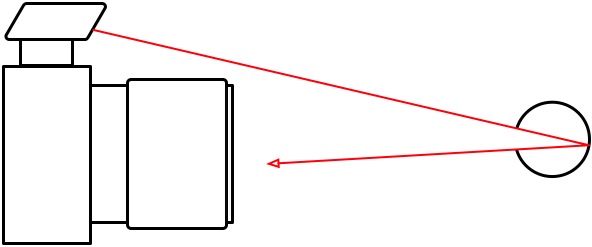
So… How do we avoid red eyes?
Removing the red eye effect can only be done by changing one of three things: The size of somebody's pupil, or the distance between the flash and the lens. Changing either of these things will reduce or remove the red eyes completely.
1) Turn off the flash.
This is the point most people forget about. Obviously, if you can do without a flash, either by increasing the light in the room, by switching a faster ISO value, or using a faster lens

No flash; no red-eyes. Simple!
2) Move the flash further away from your lens
This is a bit harder with compact cameras, but if you have an SLR, you should definitely get an external flash that connects to the hot shoe of your camera. For one thing, these flashes are a lot more sophisticated than the internal ones, but they are also are significantly further away from the lens. Because of the additional distance, the reflection from the back of your eyes never reaches the lens, and the red-eye effect is reduced or removed:
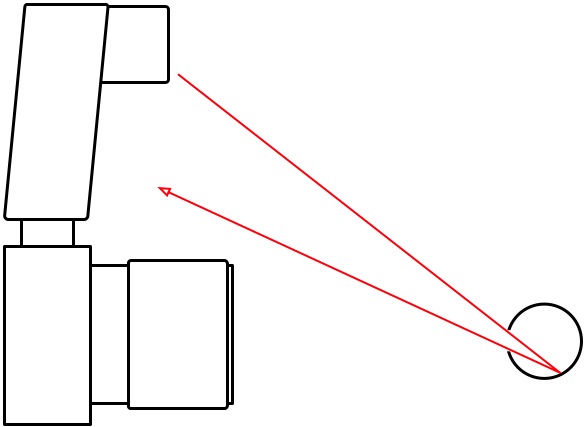
3) Make the iris smaller.
The final thing you can try is to make people's irises smaller: You may have noticed that the red-eye effect is stronger in low light (it's a little bit obvious; that's the only time you'd be using a flash anyway, right?). The reason for this is that if someone's eyes are adjusted to low light, the aperture of their eyes (their irises) will be large:
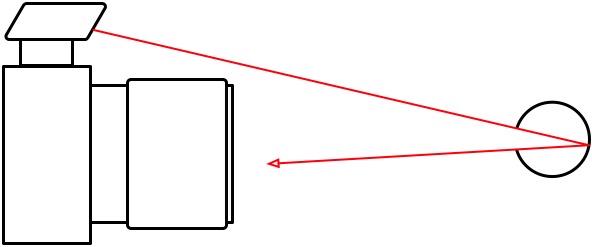
However, if there was a way to simply reduce the size of their irises, you'd get much less of a red-eye effect, simply because mot as much light would be able to hit the lens:
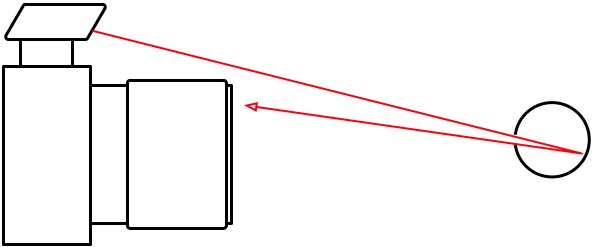
So, how do you make someone's eyes smaller? Here's three ways:
You could try to turn on the anti-red-eye function that probably exists on your camera. This function usually sends off a few short flashes, or it will shine some other sharp light into your “victim’s” eyes. This makes their irises smaller, and the problem diminishes.
Turn on more lights. This has the same effect as above, but it also has some other advantages: One, you get more even light, two, depending how sophisticated your camera is, it might fire a less powerful flash, giving a more natural light. Three: you might get away without using a flash altogether.
Make sure your subjects aren’t drunk. Have you ever noticed that if you take a set of photos at a party, how there seem to be more and more occurrences of the red eyes? Not a coincidence. People who start to become intoxicated have slower reactions – this applies to eyes as well. The eyes just won’t contract as quickly, leaving you with red-eyed pictures.
Finally a quick note on compact cameras
Switching to a faster lens on a compact camera is obviously not possible. What few people realise, however, is that almost all compact cameras have lenses that gather much more light when they are fully zoomed out.
In low light, you should therefore consider zooming out and go closer instead of using the zoom to frame your pictures. On an SLR camera, look for a lens with a larger maximum aperture.
Dear Transport for London, why do you hate dSLRs?
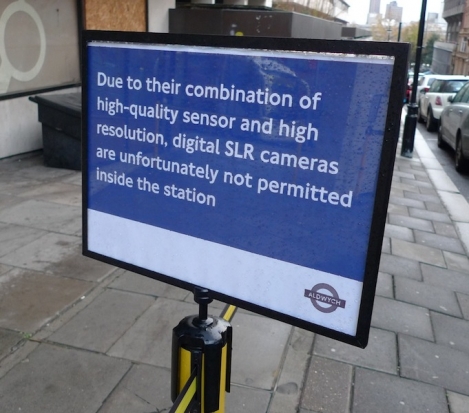
Tim's photo, taken with a compact camera
One day, someone will be able to give me an answer to the question: 'Why have you made the arbitrary decision to ban digital SLRs from your venue/ exhibit/ event, but no other type of camera?' It's a question that I seem to have to pose quite a bit, and today it's the turn of Transport for London (TfL) to attempt to respond.
What's prompted today's round with reticent PRs? Tim Allen, a Kent-based photographer took a tour of the fabled Aldwych underground station yesterday. The station's been closed for years, but it's used for training and even in films (think V for Vendetta) and very rarely, TfL will open it up to the public, at a price. When you're going on a tour of a disused underground station, taking a few photos wouldn't exactly be out of the question, would it? Except that TfL won't let you take them with a dSLR. To quote the sign outside the station yesterday:
Due to their combination of high-quality sensor and high-resolution, digital SLR cameras are unfortunately not permitted inside the underground station.
Really? So I can't walk in there with my Canon 450D, but waltzing in with a Fujifilm X-S1 (when it's released, obviously) would be absolutely fine? What on earth would they say about some medium format yumminess? And I guess that they'd have no objections to a series-topping range-finder, either?
How in the name of all that is photographically beautiful do they manage to dream up such ridiculous distinctions? And if one person dare say to me it's because dSLRs constitute professional equipment, I shall be forced to deposit the PR from every entry-level dSLR ever produced on her or his head. From a great height.
The ignorance, or maybe naivety, of these people astonishes me. If they are attempting to prevent images of their property from commercial exploitation, then prohibiting the use of dSLRs in their vicinity won't make a blind bit of difference. If they're intent on irritating anyone who owns an SLR, they're going about it just the right way.
The equipment that you use doesn't define you; and Juno and Minerva, just because you're a professional photographer it doesn't mean to say that on your day off you might not happen to enjoy taking the odd photo of something that interests you.
Thankfully for Tim he didn't turn up with his dSLR yesterday, he went for a slightly more pocketable compact camera. And he still took some photos that are now plastered all over the intergoogles.
I am, naturally, still waiting for TfL to respond to my telephone call. It's a good job that I'm not holding my breath.
Update!
And yes! There's is an update! You can read what TfL has to say for itself - and just what I think of them - over here!
Video: Using bounce flash with a compact camera
This nifty little trick will make your compact camera shots much better - and all it'll cost you is a tiny scrap of paper!
Macro photography with your mobile phone

In my second round of videos for the Nokia N8 Camera School, I'm getting up close and personal – with some bumble bees. In this video, you’ll see the Nokia N8′s macro mode in action, and the results? Well, let's just say that the compact camera manufactures have plenty to be getting worried about...
Do you enjoy a smattering of random photography links? Well, squire, I welcome thee to join me on Twitter - Follow @Photocritic
© Kamps Consulting Ltd. This article is licenced for use on Pixiq only. Please do not reproduce wholly or in part without a license. More info.
Saving money on your photography

Photography is not a cheap hobby. It probably starts out as an inexpensive past-time for most of us, maybe with a low-end compact camera or using Dad’s SLR and a couple of prints here and there – I know it did for me – but as our experience and our enthusiasm grows, so do our kit bags.
Add together the cost of an entry-level dSLR, a couple of lenses, a tripod, and a few other bits and pieces to make your life more interesting and you’ve already spent the best part of £1,000. Before long we realise that we’re having to take out insurance policies specifically covering our photographic equipment.
So if finances are a bit strained, or if you’re trying to save to go on the photographic trip of your dreams, what can you do? Ladies and Gentlemen, I present to you Small Aperture’s guide to skinflint’s photography.
Buy secondhand
From eBay to the local paper to car-boot sales to word-of-mouth there are thousands of pieces of perfectly useable photographic equipment for sale at a fraction of the price they would be brand new. Granted, they come without warranties and guarantees, but shop carefully and there are bargains to be had.
Don’t feel compelled to buy the latest model
At the moment you can pick up a Canon 450D for about £550 / $600 (Amazon UK / Amazon USA) whilst a 550D is roughly £750 / $1,000. If you’re just stepping up from a compact to an SLR the difference in specification is probably not worth £200. The same goes for lots of kit; so weigh up if the extra expense gives you suitable value-added.
Borrow equipment
Without even thinking too hard I can name two of my friends who also use Canon cameras. Did one of them lend me his wide-angle lens when I went away last weekend? Of course he did. Would I loan someone my 50mm prime lens if asked? Almost certainly.
It costs nothing to ask, just make sure you care for someone else’s kit better than you’d care for your own granny. (That is assuming that you like your granny. Otherwise pick your favourite person in the world.)
Rent equipment
Okay, so you use a Nikon and your best friend uses Pentax. You can’t borrow her macro lens for your weekend at the Eden Project, but you can always rent one.
Renting the same piece of kit over and over again will be expensive and you might as well just buy it in the long-term, but every now and again, or if you want to try before you buy, it could be worth it.
Make your own
Need a soft focus lens? Improvise with clingfilm. Don’t have a diffuser? A piece of muslin over your flash will do the job. Left your tripod on a train? Try using a piece of string. Want an interesting portrait background? Look around you: there’s sure to be something intriguing.
There is a bundle to be saved with a little ingenuity and creativity.
Try using old kit
Plenty of camera manufacturers haven’t altered their lens mounts in years. That means that many lenses from manual cameras will still fit on their digital grandchildren. Even if they don’t fit, picking up an adaptor is relatively cheap. Think of all that beautiful glass you could be using!
Use rechargeable batteries
I keep a compact camera in my handbag: it has rechargeable AA batteries in it. Got a flashgun? That’ll take AAs, too. Might as well make those rechargeable.
Use free software
If you haven’t got £230 to spend on Adobe Lightroom, there are free photo editing packages available, for example GIMP, Photoscape, and Picnik. They might not be quite as responsive as something you pay for, but they will do the job.
Shop around for printing
I’m as guilty as the next person of always using the same company to run off prints of my photos. If I were to shop around, looking online and on the high street, I might be able to save myself some pennies on printing.
I do try to save up and print in bulk, though, which is far more economical than ten photos here and there.
In summary…
The day that I realised I was frustrated with my compact camera and wanted the versatility of an SLR, I knew that I was in for the long haul, but at least I know that it doesn’t always have to cost me a king’s ransom!








